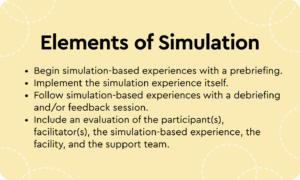
- Higher Education
- K12
- Professional
- Pricing
- Resources
-
-
-
CONTENT TYPE
-
-
-
NEW FEATURE
-
-
-
-
- Login
- Global
- CONTACT SALES EXPLORE GOREACT
Nursing Education

You know INACSL (International Nursing Association for Clinical Simulation and Learning)?
Well, we recently had two members from the INACSL Regulatory Initiative Committee—Dr. Curry-Lourenco and Dr. Loomis—join us for a workshop!
Drawn in by an article published by these INACSL members, I wanted to pick their brains about their research and how nursing programs can improve simulation exercises.
The free workshop covered a lot of information, so I’d recommend that nursing educators involved in simulation watch the full recording. That being said, there are only so many hours in the day. So if you don’t have a half-hour to watch the whole thing, I picked three workshop themes to highlight in this blog post.
These three themes will be helpful for any nursing program—no matter the strength and breadth of simulation in your program.
Check out our article: 3 Tips for Clinical Nurse Educators to Leverage Technology
First up, know your state Board of Nursing (BON) regulations for pre-licensure nursing programs. Let’s repeat this a two more times, because it’s the crux of this workshop:
Know your state Board of Nursing regulations for pre-licensure nursing programs.
Know your state Board of Nursing regulations for pre-licensure nursing programs.
If you don’t know what your state board’s regulations are—or perhaps haven’t checked them in a while—use the handy INACSL simulation regulation map. (Be aware that if you haven’t checked it since the pandemic, there may be some changes.)
Once you review your state regulations, see how you’re doing. Do you measure up? What grade would you give yourself?
With the ubiquitous nature of simulation in nursing education, it seems like this information should be readily available, right? Well, it’s not.
You’ll notice that some states are missing information. After years of work, our workshop guests are still tracking down information for each state. If you know a person or website that can fill in some current gaps, please email them at inacslinfo@inacsl.org.
From this INACSL map, you and your program will fit into one of three categories:
No matter where you fit in these three categories, the next two sections will help you up your simulation game.
During the workshop, Dr. Kim Curry-Lourenco provided a helpful list of introspective questions to help you get at key elements for creating an effective simulation exercise. While these questions work particularly well for creating a new sim exercise, they also can work as you’re reviewing and revising existing exercises.
I want to draw special attention to the last bullet point. It’s natural to focus on the simulation lab being ready, but are your students ready too?
Dr. Curry-Lourenco reminds nursing educators to put thought into prepping your students so they can get the most out of their simulation experience. This could be ensuring they’ve taken all the right courses, listened to a specific lecture, read certain materials, passed a specific skill check-off, or have been given the right information in the pre-briefing.
Finally, you need to have the right structure. This actually brings us to the basic definition of simulation that our INACSL guests provided.
See how a key phrase in this definition is “structured activities”? So what are these “structured activities” you need to tick off to make sure you’re doing a proper simulation?
Our INACSL friends gave us a handy list. Here’s a slide from the workshop listing the necessary elements for simulation:

You may be wondering just how flexible these elements are. Do you need each one for every simulation exercise you run?
According to these INACSL members, yes.
In fact, in our live Q&A, a participant asked if a simulation should be evaluated every time it’s run? (That’s the final bullet on the slide.) Their answer to that participant was yes: “It should really become part of every simulation that’s run.”
So get into the habit of making sure all these elements are there for each simulation exercise you run in your program.
There you have it! Up your simulation game by knowing your state Board of Nursing regulations, asking specific questions, and fulfilling all the simulation elements every time you run an exercise.
Now there’s a lot more that we discussed in this workshop outside these three themes. As I mentioned before, I picked these themes because they would be useful to simulation newbies, gurus, and everyone in between. But during the workshop we covered a lot of additional information such as:
If you’d like to hear more about these topics, watch the free INACSL workshop recording.